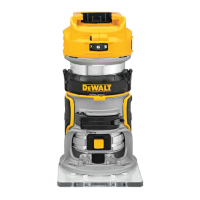ENGLISH
3
work to be performed. Use of the power tool for
operations different from those intended could result
in a hazardoussituation.
h ) Keep handles and grasping surfaces dry, clean
and free from oil and grease. Slippery handles and
grasping surfaces do not allow for safe handling and
control of the tool in unexpectedsituations.
5) Battery Tool Use and Care
a ) Recharge only with the charger specified by the
manufacturer. A charger that is suitable for one type
of battery pack may create a risk of fire when used
with another batterypack.
b ) Use power tools only with specifically designated
battery packs. Use of any other battery packs may
create a risk of injury andfire.
c ) When battery pack is not in use, keep it away
from other metal objects, like paper clips, coins,
keys, nails, screws or other small metal objects,
that can make a connection from one terminal to
another. Shorting the battery terminals together may
cause burns or afire.
d ) Under abusive conditions, liquid may be ejected
from the battery; avoid contact. If contact
accidentally occurs, flush with water. If liquid
contacts eyes, additionally seek medical help.
Liquid ejected from the battery may cause irritation
orburns.
e ) Do not use a battery pack or tool that is
damaged or modified. Damaged or modified
batteries may exhibit unpredictable behavior resulting
in fire, explosion or risk ofinjury.
f ) Do not expose a battery pack or tool to
fire or excessive temperature. Exposure to
fire or temperature above 265 °F (130°C) may
causeexplosion.
g ) Follow all charging instructions and do not
charge the battery pack or tool outside the
temperature range specified in the instructions.
Charging improperly or at temperatures outside the
specified range may damage the battery and increase
the risk of fire.
6) Service
a ) Have your power tool serviced by a qualified
repair person using only identical replacement
parts. This will ensure that the safety of the power
tool ismaintained.
b ) Never service damaged battery packs. Service
of battery packs should only be performed by the
manufacturer or authorized serviceproviders.
Additional Safety Rules for Routers
• Hold power tool by insulated gripping surfaces,
when performing an operation where the cutting
accessory may contact hidden wiring. Cutting
accessory contacting a “live” wire may make exposed
metal parts of the power tool “live” and could give the
operator an electricshock.
• Use clamps or another practical way to secure and
support the workpiece to a stable platform. Holding
the work by hand or against your body leaves it unstable
and may lead to loss ofcontrol.
• DO NOT cutmetal.
• Keep handles and gripping surfaces dry, clean, and
free from oil and grease. This will enable better control
of thetool.
• Maintain firm grip with both hands on the tool to
resist startingtorque. Maintain a firm grip on the tool
at all times whileoperating.
• Always follow the bit manufacturer’s speed
recommendations as some bit designs require
specific speeds for safety or performance. If you are
unsure of the proper speed or are experiencing any type of
problem, contact the bitmanufacturer.
• Keep hands away from cutting area above and
below the base. Never reach under the workpiece for
any reason. Keep the router base firmly in contact with
the workpiece whencutting.
• Never run the motor unit when it is not inserted in
one of the router bases. The motor is not designed to
behandheld.
• Keep cutting pressure constant. Do not overloadmotor.
• Use sharp bits. Dull bits may cause the router to swerve
or stall underpressure.
• Be sure that the motor has stopped completely
before you lay the router down. If the cutter head is still
spinning when the tool is laid down, it could cause injury
ordamage.
• Be sure that the router bit is clear of the workpiece
before starting the motor. If the bit is in contact with
the workpiece when the motor starts, it could make the
router jump, causing damage orinjury.
• ALWAYS disconnect tool from power source before
making adjustments or changingbits.
• Keep hands clear of bit when motor is running to
prevent personalinjury.
• NEVER touch the bit immediately after use. It may be
extremelyhot.
• Provide clearance under workpiece for router bit
when through-cutting.
• Tighten collet nut securely to prevent the bit
fromslipping.
• Never tighten collet nut without abit.
• Do not use router bits with a cutting diameter in
excess of 1-3/8" (34.9mm) in thistool.
• Always use cutters with a shank diameter of 1/4"
(6.4 mm) which corresponds to the size of the collet
in yourtool.
• Always follow the bit manufacturer's speed
recommendations as some bit designs require
specific speeds for safety or performance. If you are
unsure of the proper speed or are experiencing any type of
problem, contact the bitmanufacturer.
• Not recommended for use in a routertable.
• Avoid climb-cutting (cutting in the opposite
direction of that shown in FigureQ). Climb-cutting
increases the chance for loss of control resulting in

